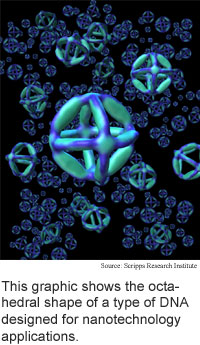
DNA folds into paired pyramids
Researchers from the Scripps Research Institute
have formed strings of DNA that spontaneously fold into a wireframe octahedron,
a shape that has eight triangular faces.
The shape is a step forward in the quest to use DNA to make nanoscale
templates that can be used to make materials molecule-by-molecule and
structures that form microscopic machines.
The octahedron has two advantages over other artificially-formed
three-dimensional DNA shapes, according to the researchers. First, because
the structures are triangular, they're relatively strong. Second, like
a three-dimensional paper airplane made from a flat piece of paper, the
octahedron is made from straight DNA strands. The three-dimensional shape
forms when one long DNA strand and five shorter strands are mixed and
heated.
The straight strands can be coaxed to self-replicate, making it
possible to quickly produce large numbers of the octahedrons, according
to the researchers. Other three-dimensional DNA shapes must be synthesized
chemically rather than biologically. DNA is made up of strings of four
bases attached to a sugar-phosphate backbone. DNA strands that contain
complementary sequences of bases can attach to each other.
The DNA octahedron measures 22 nanometers across, or about one
fiftieth the width of an E. coli bacterium.
The DNA octahedron could be used in practical applications in
five to ten years, according to the researchers. The work appeared in
the February 12, 2004 issue of Nature.
Net plan builds in search
Robot guided by its voice
Angle speeds plastic transistor
Sturdy quantum computing demoed
Briefs:
DNA folds into paired pyramids
Fiber spun from nanotube smoke
Material boosts thermoelectricity
Nano ribbons coil into rings
Simulation maps nano patterns
Chip-camera combo tracks viruses

Research Watch blog
View from the High Ground Q&A
How It Works
RSS Feeds:
News
Ad links:
Buy an ad link
Ad links: Clear History
Buy an ad link
|
TRN
Newswire and Headline Feeds for Web sites
|
© Copyright Technology Research News, LLC 2000-2010. All rights reserved.